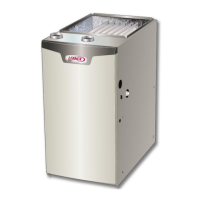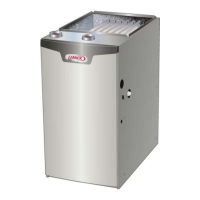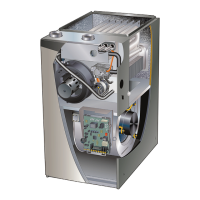Page 72
Details of Intake and Exhaust Piping Terminations for
Direct Vent Installations
NOTE - In Direct Vent installations, combustion air is taken
from outdoors and ue gases are discharged to outdoors.
NOTE - Flue gas may be slightly acidic and may adverse-
ly aect some building materials. If any vent termination
is used and the ue gasses may impinge on the building
material, a corrosion-resistant shield (minimum 24 inches
square) should be used to protect the wall surface. If the
optional tee is used, the protective shield is recommend-
ed. The shield should be constructed using wood, plastic,
sheet metal or other suitable material. All seams, joints,
cracks, etc. in the aected area should be sealed using an
appropriate sealant. See FIGURE 35.
Intake and exhaust pipes may be routed either horizontal-
ly through an outside wall or vertically through the roof. In
attic or closet installations, vertical termination through the
roof is preferred. FIGURE 32 through FIGURE 40 show
typical terminations.
1 - Intake and exhaust terminations are not required
to be in the same pressure zone. You may exit the
intake on one side of the structure and the exhaust
on another side (FIGURE 33). You may exit the
exhaust out the roof and the intake out the side of
the structure (FIGURE 34).
2 - Intake and exhaust pipes should be placed as close
together as possible at termination end (refer to
illustrations). Maximum separation is 3” (76MM)
on roof terminations and 6” (152MM) on side wall
terminations.
NOTE - When venting in dierent pressure zones,
the maximum separation requirement of intake and
exhaust pipe DOES NOT apply.
3 - On roof terminations, the intake piping should
terminate straight down using two 90° elbows (See
FIGURE 32).
4 - Exhaust piping must terminate straight out or up as
shown. A reducer may be required on the exhaust
piping at the point where it exits the structure to
improve the velocity of exhaust away from the
intake piping. See TABLE 27.
NOTE - Care must be taken to avoid recirculation of
exhaust back into intake pipe.
5 - On eld-supplied terminations for side wall exit,
exhaust piping may extend a maximum of 12 inches
(305MM) for 2” PVC and 20 inches (508MM) for 3”
(76MM) PVC beyond the outside wall. Intake piping
should be as short as possible. See FIGURE 35.
6 - On eld-supplied terminations, a minimum distance
between the end of the exhaust pipe and the end of
the intake pipe without a termination elbow is 8” and
a minimum distance of 6” with a termination elbow.
See FIGURE 35.
UNCONDITIONED
ATTIC SPACE
3”(76mm) MAX.
12” (305mm) ABOVE
AVERAGE SNOW
ACCUMULATION
3” (76mm) OR
2” (51mm) PVC
PROVIDE SUPPORT
FOR INTAKE AND
EXHAUST LINES
8” (203mm) MIN
Inches(mm)
DIRECT VENT ROOF TERMINATION KIT
(15F75 or 44J41)
FIGURE 32
Exhaust
Pipe
Furnace
Exiting Exhaust and Intake Vent
(different pressure zone)
Inlet Air
(Minimum 12 in.
305 MM) above
grade or snow
accumulation
FIGURE 33
Roof T
erminated
Exhaust Pipe
Furnace
Exiting Exhaust and Intake Vent
(different pressure zone)
Inlet Air
(Minimum 12 in.
305 MM) above
grade or snow
accumulation
FIGURE 34

